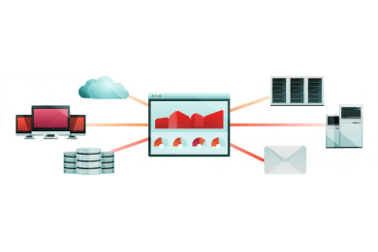Like most application performance monitoring software (APM) solutions, SiteScope is designed to help your IT team spend less time struggling with incidents and instead spend more time identifying and mitigating risks before they become incidents.
Similarly, the status page software StatusCast is designed to take the burden of communicating about scheduled maintenance, unplanned downtime, and other uptime-related alerts and updates off of your IT team.
Together, these tools empower your IT team to focus on the ounce of prevention rather than the pound of treatment.
Technologically speaking – how can these tools work together?
Out-of-the-Box Integrations with SiteScope
SiteScope can run on Windows, UNIX, and Linux platforms. It monitors more than 100 different target types for critical health and performance characteristics (including tools from Amazon, Hadoop, Cisco, Citrix, Microsoft, Oracle/Sun, SAP, SAS, Siebel, VMware, WebLogic and other custom monitors via the Live Network), and bridges the gap from IT pro to typical end-user through its integration with application status page tools like StatusCast.
SiteScope also integrates with other products and services, most notably Operations Manager (proactively performs root cause analysis) and Performance Center (facilitates application performance testing). SiteScope’s integration with Operations Manager actually allows for agentless monitoring across heterogeneous IT infrastructure components. This is significant because without an agent infrastructure in place, most APM tools can only monitor network components on the same environment.
Integrating with StatusCast to Create a Status Page
This provides your customers with transparency about the performance of your application. StatusCast can send updates to your end users immediately, it can be set to wait a certain amount of time before sending updates, or it can be set to not send any updates without manual intervention (see workflows below, under Step 2. Automate incident posting). Likely you will send different updates at each of the three settings, as some issues are best handled by immediate transparency with the customer, others are better communicated after they’re better understood by your team, and some may require human attention before being sent out at all.
StatusCast makes communicating with your end users an easy task, without compromising the quality of that communication. This is because you are using information you already have at your fingertips—in SiteScope—and merely applying that information to another audience (after a bit of polishing)—your end users!
How to Set Up the Integration between SiteScope and StatusCast: 3 Quick Steps
1. Set up your API key
Copy your API Key, navigate to the Integrations section of your StatusCast admin portal [yourapp].statuscast.com/admin), and select the Install button under HP SiteScope.
2. Automate incident posting
Choose HP SiteScope from the Choose Provider drop down.
Next, select the Alert Name from the list (this will correspond to a specific application in your SiteScope account). Enter a name for Authored by, which defines who is the author of each incident. Just like normal incidents, a post can have only a single author:
The other Incident settings, including Type, Affected components, Subject, and Message, reflect the same general options you have when creating an incident. For more information on this process, please refer to StatusCast’s article How Do I Post a New Incident or Status?
At this point you can set up a workflow for the incident:
Once you set all the configurations, click Submit to save the configuration.
3. Add SiteScope metrics to your StatusCast page
To configure the metric, navigate to the Layout section. Drag the Metric widget into your pages layout, select the pencil edit icon, and select New Metric.
From here you can configure the metric you’d like to display:
Display name: Enter a friendly name to identify this metric within StatusCast.
Choose provider: Select HP SiteScope as your provider.
Choose application: Select the application from your SiteScope account from which you want metric data made available to StatusCast.
Metric: Select the type of metric you wish to make available, e.g., Response Time.
Select Save to add the SiteScope metric to your layout, and to finalize these changes, select the Save & Publish option on the right.
Now that your metric has been added to your StatusCast page, navigate to the page to see it in action!
Integrating with SiteScope Application Performance Monitoring Software
I hope this blog has helped you understand some of the monitoring capabilities of SiteScope and what an integration with StatusCast can do for you.






